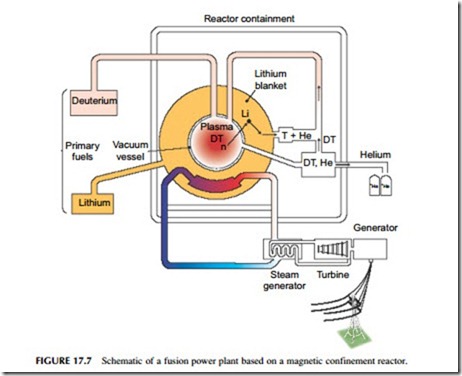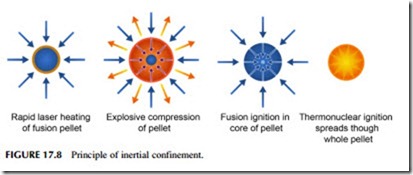NUCLEAR FUSION
Nuclear fusion, the reaction that fuels the sun and the stars, has excited scientists and technologists ever since the process was identified during the 1930s. Unsuccessful attempts at fusion took place during the 1930s but halted during World War II. Experimental work restarted during the late 1940s. Since then a series of fusion reactors have been built around the world. Around 20 are in operation today.
In 1958 at an Atoms for Peace conference in Geneva, fusion research was established as an international collaborative venture and at least one strand of fusion development, which based on magnetic confinement, has remained inter- national in flavor ever since. The necessity for this was reinforced during the 1970s when it became clear that the cost of developing fusion was likely to be beyond the resources of any one nation.
While large fusion reactors based on magnetic confinement were being built in the United States, Europe, and Japan, other developments remained hidden behind the security of nuclear armaments research. Fusion is the basis for the hydrogen bomb and so much of the research into its development and control remained secret until very recently. It is this research that has led to the idea of inertial confinement, an entirely different approach to fusion for power generation. During the last five years the veil of secrecy has at least partly dropped and a major program in the United States aims to develop a demonstration power plant during the 2020s. Meanwhile, the largest international magnetic confinement reactor is under construction in the south of France and should start experiments at around the same time.
Magnetic Confinement
The fusion reaction between deuterium and tritium (DT) discussed earlier is the easiest to achieve in a reactor, but even so it requires extremes of both temperature and pressure. If it can be mastered, then potentially fusion could provide almost limitless amounts of energy. In theory, 1 tonne of deuterium could pro- vide the equivalent of 3 x 1010 tonnes of coal.
The temperature required to achieve fusion with DT is over 100 x 106 oC. Under these conditions the atoms disintegrate to create a sea of electrons and nuclei, a fourth state of matter called a plasma. There are no materials in exis- tence that can survive the plasma temperature, so an alternative way has to be found to contain and control the plasma. The most promising solution is by means of a magnetic field (Figure 17.7).
Magnetic containment was recognized early in fusion research as the only way to maintain a fusion plasma, but it was not until the 1950s that the best form of magnetic field, the torroidal field, was identified by scientists in Russia. Here a device called a tokamak was developed, and in the early 1960s experimental results showed that the high temperatures required for fusion could be achieved with this device.
Since then a series of ever larger tokamak reactors have been constructed. The most important of these were the joint European torus (JET) at Culham, UK, Tokamak fusion test reactor (TFTR) at Princeton, NJ, JT-60U in Naka, Japan, and T-15 in Moscow, Russia. Both TFTR and JET experimented with
DT fuel from the beginning of the 1990s, and in 1997 JET established the record for the greatest amount of energy generated by a fusion reactor, 16 MW.
Even with this output, the reactor consumed more energy than it generated. JET achieved a power-in-to-power-out ratio (the gain of the reactor) of around 0.7. A gain of 1 represents the breakeven point. Even more crucially, JET could only maintain the plasma burst for five seconds. If it continued for longer, its systems would begin to overheat.
The next stage in magnetic confinement fusion development is the international thermonuclear experimental reactor (ITER—the word is also Latin for “the way”). This project was first conceived in 1988 and an agreement to build the plant was finally signed in 2007 by the EU, Russia, Japan, United States, China, India, and South Korea.
ITER will have a plasma volume of 800 m3 and a power output of 500 MWth, 30 times that of JET. Fusion energy generation is a matter of size and at this size it is hoped that ITER will have a gain of 10, producing 500 MWth from an input of 50 MWth. This will be sufficient to prove fusion as a net source of energy, but ITER has not been designed to generate power, so it will not have all the features needed for a demonstration plant. That will have to wait until the successor to ITER.
Inertial Confinement
While magnetic confinement seeks to create a stable continuous plasma in which fusion can take place, the alternative—inertial confinement—seeks instead to generate energy from a series of discrete fusion reactions producing a burst of energy each time (Figure 17.8). In an inertial confinement reactor, small capsules containing around 150 mg of a mixture of deuterium and tritium (DT) are exposed to a massive pulse of energy from multiple lasers. When the laser beams strike the capsule they create an explosion of X-rays from its surface, and these in turn (by the mechanical principle of action and reaction) create a pressure pulse that heats and compresses the DT mixture with such vigor that the conditions for fusion are generated at its core. One fusion starts, the reaction radiates outwards through the DT mixture faster than the actual molecules can expand and escape (they are “confined” by their inertia), and so the whole charge undergoes fusion and releases a pulse of energy.
To make this into a means of generating power, these small exploding suns must be created at a relatively rapid rate of perhaps 15 each second. This sounds both exacting and ambitious, but it is exactly what a U.S. program proposes. To achieve it, the U.S. government has built the National Ignition Facility (NIF), a
$5 billion project that is intended to serve both military and civilian research.
NIF is provided with 192 lasers capable of providing a pulse of up to 5 MJ of energy and it has so far produced 1.8 GJ, equivalent to a delivery rate of 500 TW of energy. All the energy contained in the laser beams is focused onto the 150 mg of DT. NIF is only capable of single-shot experiments rather than the continuous operation required for a power plant. Since it started in 2009 it has carried out a series of experiments trying to achieve ignition, the point at which the DT produces more fusion energy than the lasers pump into it. By 2013 it was a factor of two or three short of ignition.
Alongside NIF is the Laser Inertial Fusion Energy (LIFE) project, a collaboration of scientists, technologists, utilities, and regulators that are seeking to design a power plant capable of exploiting inertial confinement. Current plants see a demonstration project constructed between 2020 and 2030 and commercial plants available by 2030 or soon afterwards.
Tritium Production
For either magnetic confinement or inertial confinement to become successful sources of electrical power, each needs a source of tritium. This can be generated in a nuclear reaction from lithium. To provide self-sustaining power plants, each type of plant will have to produce its own tritium. Under current designs it is conceived that this will be manufactured in a “blanket” that surrounds the core of the fusion reactor, much in the same way as breeder reactors produce their own fuel. Liquid lithium might also be used as the reactor coolant although alternatives might prove easier to manage.
Designing the blanket and heat-recovery system is one of a number of major hurdles that have to be jumped if fusion is to become viable commercially. While the goal is still distant, it seems more likely to be achieved than it has at any stage in the past.

